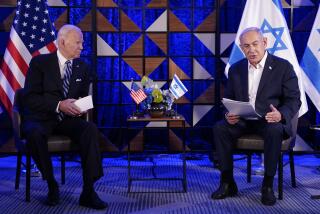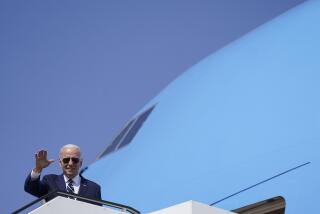Ties With India Will Improve, U.S. Aide Says
- Share via
NEW DELHI — Fred C. Ikle, the Pentagon’s senior policy official who is here to complete a technology-sharing agreement that will have military applications for India, predicted Friday a “new chapter in Indo-U.S. relations” similar to the emerging relationship between the United States and China.
The long-term policy objectives outlined by Ikle in an interview here with four American reporters mark a significant departure from what has been a distant U.S. attitude toward India, the world’s second-most-populous country.
By the end of this century, Ikle said, India “could be a power that contributes to world stability the way the U.S. will see it and want to shape it--a power we can work together with, much as we try to work together with other major powers now to enhance our long-term national security aims.”
Parallels With China
“It has certain parallels with our changing relationship with China,” he added. “Our concern with China in the ‘50s was its wanting to spread all over Asia, wanting to take on Vietnam, pieces of India and Korea and Japan. Now we have a different attitude toward China. We have a common strategic interest and a feeling in the West that China is not now pushing to take over neighboring countries.”
The visit here by Ikle, the under secretary of defense for policy, and one next week by U.S. Air Force Secretary Verne Orr, a month before a scheduled trip by Indian Prime Minister Rajiv Gandhi to the United States, comes at a time when Reagan Administration officials are optimistic about the possibilities of closer ties with India under the leadership of the new prime minister, son of assassinated Prime Minister Indira Gandhi.
Rajiv Gandhi, 40, is seen as a Western-style, technology-minded leader--”a college Joe,” one Western political analyst here said. He studied engineering at Cambridge University in Britain and, before entering politics in 1981, was a commercial airline pilot trained on American jets.
‘An Up Period for Us’
“This new government is an up period for us,” one senior U.S. official said.
Additionally, U.S. officials see India gradually moving away from the Soviet Union as its almost-exclusive supplier of military equipment. In an effort to speed that development, the United States appears ready to sell certain weapons systems to India and provide selective technology that the Indians can use to advance their substantial arms production system.
“They (Indian leaders) want to become independent of their present main arms supplier, turning more to Western Europe and diversifying and producing a lot of things at home--building up their own strategic arms industry and by the end of the century becoming an autonomous military power,” a senior U.S. official said.
Americans involved in negotiations with Indian defense officials said that specific weapons systems that might be bought by India were discussed during Ikle’s visit, which ends today after he tours military production facilities in Bangalore, “but not how this was going to be paid for.”
Indian military leaders are known to be interested in U.S.-produced 155-millimeter howitzers and certain missiles.
India-Soviet Pact
But India enjoys a very favorable trade agreement with the Soviet Union on weapons purchases. In exchange for Indian purchases of its weapons, the Soviets agree to use the money to buy Indian products.
The United States has not supplied India with any significant weaponry since 1964, after the Indo-Chinese war when Britain and the United States sent $100 million worth of equipment to six divisions of Indian troops on the Chinese border.
Of more immediate importance to the two countries is a technology-transfer agreement under negotiation. So far, it is the highlight of the improved Indo-U.S. relationship. Under the agreement, which has been initialed by U.S. Ambassador Harry G. Barnes Jr. and former Indian Foreign Secretary M.K. Rasgotra, the United States agrees to release certain high technology to India, including some with obvious military application for the Indians.
Chafed at Restrictions
Because of the military parts of the agreement, almost every item must first be approved by the Department of Defense in Washington. U.S. officials are hoping to conclude the agreement--which includes technology for sensing devices, sensitive measuring equipment and computers--before Gandhi visits Washington in June.
Indian officials, however, have chafed under certain U.S. restrictions, particularly on nuclear-related technology and sophisticated military technology that is also sought by the Soviet Union.
“Some people here seem to be concerned that we are worried about India (leaking technology),” said one U.S. official involved in the talks. “That is not the case. We are worried more about the risk of high technology being stolen by the Russians. . . . We did not mean the government of India would be handing things over.”
Despite the snags in the technology agreement, the U.S. officials indicated that the two countries were near an accord. “Everything is buttoned down now. Final formal approval, I hope is just around the corner,” one said.
More to Read
Sign up for Essential California
The most important California stories and recommendations in your inbox every morning.
You may occasionally receive promotional content from the Los Angeles Times.













